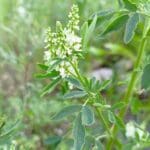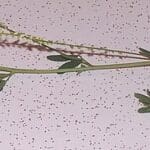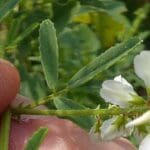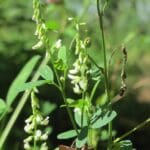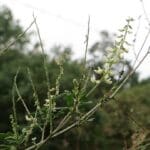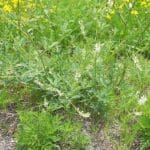White Melilot / Spring / Summer / Edible
White Melilot can often be found growing on disturbed ground and can have a flavour somewhere between peas and vanilla.
Common Names
Sweet Clover, Hart’s Tree, Kings Clover, Lucerne.
Botanical Name
Melilotus albus
Scientific Classification
Kingdom – Plantae
Order – Fabales
Family – Fabaceae
Physical Characteristics of White Melilot
Erect branched annual or biennial, up to 150cm high. The stems are round and can be slightly ribbed or furrowed, without any hairs.
Leaves
Sharply toothed trifolate leaves, alternate up the stem, approximately 1 to 5cm in length.
Flowers
White, 4 to 5mm in many flowered racemes with the standard petal longer than the wings and keel.
Fruits
Ridged and hairless, 4 to 5mm, brown when ripe.
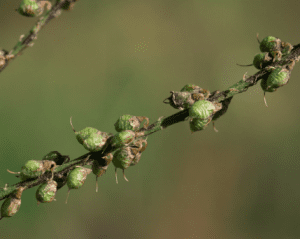
Habitat
Introduced from Europe and Asia. Casual or naturalised in England and up to central Scotland, but commonest in South East England.
Arable land, waste ground, roadsides. Doesn’t like acidic soils, particularly if they are wet.
Known Hazards
Use sparingly. Over consumption can cause nausea. Some people report getting a headache at the smell of this plant.
The presence of a mould on White Melilot, produces coumarin which is a blood thinner, therefore this plant is contraindicated if taking blood thinners. If dehydrating, always dry thoroughly and completely. Any damp conditions will allow the mould that creates the coumarins to flourish and render your harvest inedible and quite toxic. Do not ferment as this can also increase the coumarin content.
Could be confused with
There are several species of Melilot and they all look very similar. White Melilot, as the name suggests has white flowers. The only other species of Melilot with white flowers is Small Melilot, (Melilotus indicus), but this is much shorter.
Traditionally Melilot has been used as fodder for cattle and horses, but because high amounts of coumarins can build up if it is too damp, due to the presence of mould, it is used sparingly and mixed with other feed over winter.
Edible Uses
The young leaves can be eaten raw before the plant flowers, after which time they become a tad too bitter, although they are still bitter and aromatic when young. They are a good addition in salads.
All the upper parts of the plant can be thoroughly dried and used to make a tea with a vanilla flavour.
The young shoots can be picked and cooked like asparagus
The flowers taste lovely and sweet and can be added to blossom jams and jellies, for cake decorations, sprinkled in pancake batters, tossed through salads and dropped into tea or cocktails.
The seeds can be used as a seasoning when crushed.
The leaves and seedpods can be used to make a soup and the pea like seeds can be used in a similar way to split peas.
Use sparingly. Over consumption can cause nausea. Some people report getting a headache at the smell of this plant.
Notes on Herbal uses
The whole plant, when harvested in flower is carminative and emollient. The dried leaves contain coumarins which are anti clotting and it is this phyto-chemical that is used to make warfarin.
It has also been used topically in the past to apply to any type of swelling.
Folklore
It was once thought that washing the head of a person who has gone mad or apoplectic with distilled Melilot would drive the madness away, and if it is boiled in wine, it can be used to cure inflamed eyes!
Extra notes from the Foragers
Melilotus means honey lotus, from two Greek words, the latter the name of a Greek plant, possibly Clover, or meaning fragrant like the Lotus. Abus means white.



